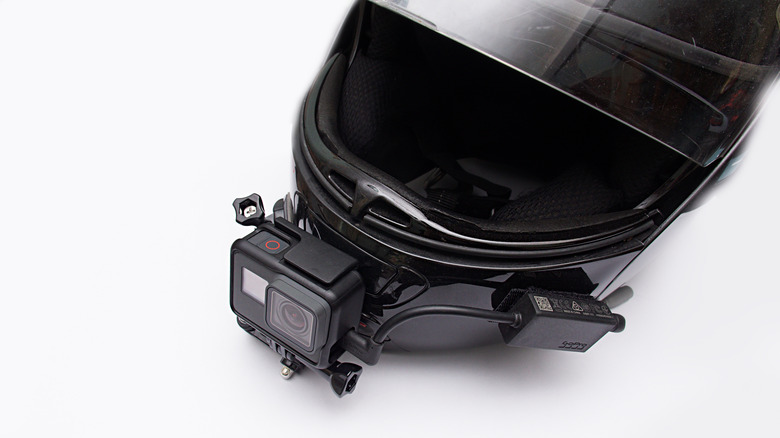Are GoPro Cameras On Motorcycle Helmets Actually Illegal? The Rule Bikers Should Know
GoPros are a great way to record activities where it isn't quite possible to keep a selfie stick at hand. One such example is cycling, where riders often mount GoPros on their helmets to record their trails. The legality of GoPro or other action cameras on motorcycle helmets starts with the U.S. Department of Transportation (DOT). Its Federal Motor Vehicle Safety Standard 218 sets strict helmet requirements, including a rule that no rigid projection should extend more than 5 millimeters (0.20 inches) from the surface.
Because most cameras and mounts exceed that measurement, a helmet with a GoPro attached is technically not compliant. This standard is meant to prevent snag points that could catch on objects in a crash and increase the risk of injury. Helmet makers echo that warning, advising riders not to drill or modify their helmets and cautioning that non-approved accessories may void certification. That doesn't mean there aren't legal ways to customize your helmet, though.
A BBC-commissioned study on climbing helmets suggested mounts do not always worsen impact safety and sometimes absorb force, but it also found angled hits can increase rotational forces, especially with solid attachments. While manufacturers argue their adhesive mounts break away on impact, there is no binding scientific consensus, leaving the risks unclear. What complicates matters further is that states decide on enforcement differently. DOT standards apply nationally, but not every state enforces them the same way, creating a patchwork of rules. For riders, this means that a helmet camera might be fine in one state, tolerated in another, and ticketed in states with stricter helmet laws, such as California.
State differences: Indiana, Kentucky, and California
Indiana does not have a specific law banning cameras, and no state statute prevents riders from attaching a GoPro. The main limitation is not compromising the helmet's integrity. Riders are advised not to drill into the shell but can use adhesive or suction mounts, which do not directly alter the structure. Enforcement is rare, especially since helmets themselves are not mandatory for riders over 18 with a full license.
Kentucky follows the same procedure. The law does not specify any rules about helmet cameras, so officers must decide on their own whether to allow them. Helmet use is only mandatory for riders under 21, those with a permit, or anyone licensed for less than a year. As in Indiana, DOT compliance is expected for required helmets, and a mounted camera could be seen as a violation if it affects certification. The enforcement of laws in Kentucky shows no consistency because different areas of the state have their own rules, which can create confusion for motorcyclists.
California maintains a unique position because it has both a mandatory helmet law and enhanced traffic enforcement. All riders and passengers must wear DOT-approved helmets, and state guidelines follow the 5 mm rule. A GoPro protruding from a helmet makes it non-compliant, and tickets of $250 are possible. California evaluates accessories for helmets to determine if they create safety risks, which adds an additional assessment step. But that's only three states out of fifty, and each one has its own laws. You should always check your state's local laws and guidelines to be on the right side of the law at all times.
Safety, evidence, and practical alternatives
Beyond the legal details, safety concerns shape much of the helmet camera debate. While riders use GoPros to capture scenic rides or record evidence during accidents (amongst other, more creative uses), any modification raises questions about helmet performance. In Indiana, attorneys note that helmet footage can be critical in identifying fleeing drivers or documenting conditions at the time of a crash.
Still, insurers may argue that a modified helmet failed to protect properly, especially if a protrusion caused extra injury. Kentucky's approach is similar: while not illegal, officers may view a mount as compromising helmet safety. Riders face uncertainty about whether the benefits outweigh the risks. California's stricter enforcement highlights the tension between documentation and compliance, especially since a non-compliant helmet technically leaves riders without legal protection under helmet laws.
Safety studies add to the complexity. A 2015 Transport Research Laboratory study commissioned by the BBC tested helmet-mounted cameras in climbing and cycling helmets, finding no failures of injury thresholds in over 70 tests. In some cases, mounts absorbed energy rather than increasing impact. However, angled blows and snag points did increase force transfer to the head, raising concerns about glancing impacts. Riders can avoid some risks with alternatives. Chin mounts and strap systems keep cameras lower profile and less intrusive. Handlebar or chest mounts bypass helmet laws entirely while still allowing riders to record their rides. And in the meantime, if you have already recorded some breathtaking videos with your GoPro, here are some tips and tricks for editing them like a pro.


